Abstract
The intelligent production of sheet metal is a comprehensive technology involving control science, computer science, and sheet metal production. Intelligent rolling is an important development in the production process of sheet metal. In this paper, a new symmetrical four-roller bending (SFRB) process is introduced, which consists of feeding, pre-bending, reverse roll bending, second bending, and forward roll bending and unloading. A control strategy is proposed for the process, including on-line monitoring of curvature, on-line identification of the springback law, on-line prediction of final reduction, and control strategy. A convenient and reliable on-line curvature monitoring method is proposed. The quantitative relationship between the reduction and the curvature, in the form of a quadratic function, was established by physical experiments and numerical simulation, and the online identification of the springback law was realized. An on-line prediction method of the final reduction is proposed, and the determination principle of the reduction of three pre-bending processes is given. Finally, the control strategy of the SFRB process was verified by physical experiments. The relative error of the curvature radius of the final formed parts can be controlled within 0.8%. This research provides new insights into intelligent rolling.
1. Introduction
The intelligent production of sheet metal is a comprehensive subject that combines control science, computer science, and sheet metal production theory [1]. Intelligent rolling is an important development in the production process of sheet metal. According to the different number of rollers, the roll bending process can be divided into three forms, namely, two-roller, three-roller, and four-roller. In view of different forms of rolling process, scholars have undertaken a significant amount of research on the relationship between the forming curvature and reduction, defect formation, and structural optimization, using theoretical analysis, numerical simulation, and experimental research methods. In the field of three-roller bending, using different methods, Gandhi et al. [2], Zhang et al. [3], Hu and Wang [4], Gandhi et al. [5] and Fu et al. [6], Quan et al. [7], Chudasama et al. [8], and Yu et al. [9,10] constructed mathematical models and obtained theoretical results. Zeng et al. [11], Ktari et al. [12], and Feng et al. [13,14] carried out numerical simulations to obtain the deformation characteristics of the three-roller bending process. Huang et al. [15] presented a new three-roller setting round process to achieve calibration of the roundness of a whole pipe without changing the pipe circumference. In the field of four-roller bending, Hua et al. [16,17], Gao et al. [18], and Sun et al. [19,20] established mathematical models, and Gu et al. [21] developed a finite element model to analyze the four-roll bending process. Yu et al. [22] developed the SFRB process and predicted the reduction of the upper roller; results showed the ovality of the formed part was less than 5%. Li et al. [23] analyzed the two-roller bending process and established a theoretical model. Gong et al. [24] analyzed the main influencing factors and the distribution of stress and strain.
Because of the simplification of engineering plastic mechanical and material constitutive models, such as the linear kinematic, linear isotropic, and simple kinematic hardening models [9,25,26], it remains a challenge to accurately calculate the reduction according to the target curvature. In production, this mainly depends on the experience of workers and die adjustment, which greatly reduces the production efficiency, and errors are certain to occur. The intelligent control of sheet metal forming is an effective way to address the above problems. Errors caused by theoretical analysis can be compensated for by the monitoring, identification, prediction, and control of the deformation law.
Zhao et al. [1] carried out intelligent drawing of both axisymmetric and non-axisymmetric parts. Li [27] developed an intelligent control system of the JCO forming process for LASW pipes, including theoretical analysis, real-time monitoring of the forming process, identification of material performance parameters, and prediction of process parameters. Zhao et al. [28] developed the control strategy of multi-point bending one-off straightening and control strategy of three-point bending, multi-step straightening. Zhao et al. [29,30] constructed an over-bending setting round intelligent control system for the pipe ends of large pipes, including a pipe-end ovality recognition system, two-step and three-step over-bending setting round control strategy, and real-time prediction of optimum process parameters.
This paper aims to enhance the existing research related to roll bending by proposing the SFRB process. A control strategy is proposed for this process, including on-line monitoring of curvature, on-line identification of the springback law, on-line prediction of the final reduction, and a control strategy process. A convenient and reliable on-line curvature monitoring method is also proposed. The quantitative relationship between the reduction and the curvature was established by physical experiments and numerical simulation, and the online identification of the springback law was realized. An on-line prediction method of the final reduction is also proposed, and the determination principle of the reduction of three pre-bending processes is outlined. Finally, the control strategy of the SFRB process was verified by physical experiments. This research provides new insights into intelligent rolling.
2. SFRB Process
The main working parts of the process are two upper rollers and two lower rollers. The two upper rollers are on the top and active, and the other two rollers are at the bottom and driven. The four rollers are symmetrical along the vertical plane. As shown in Figure 1, the main process includes feeding, pre-bending, reverse roll bending, final bending, positive roll bending, unload, and springback [22]. The process has the advantages of high forming precision, small remaining straight edge, high production efficiency, and simple equipment structure.
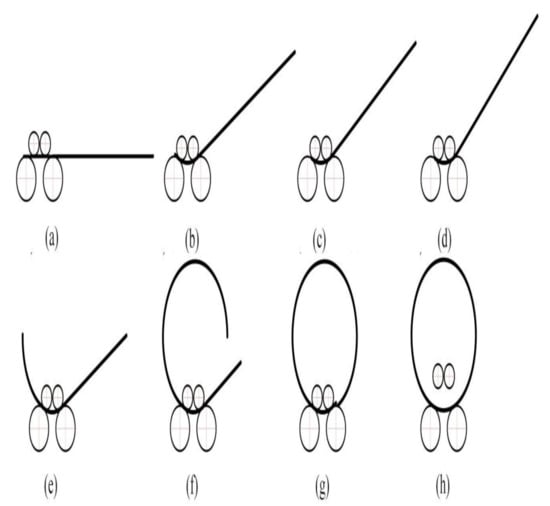
Figure 1.
SFRB process: (a) feeding, (b) pre-bending, (c) reverse roll bending, (d) final bending, (e) positive roll bending, (f) positive roll bending, (g) bending completion, (h) unload and springback.
3. Control Strategy
3.1. Online Monitoring of Curvature
On-line real-time monitoring of the roller bending process can reflect the macroscopic mechanical and geometric parameters of the processed object by adopting effective testing methods. The curvature radius is an important parameter to be monitored online during the roller bending process. At present, in actual production, the method of manual measurement is mostly adopted, which has low efficiency and large error. To realize the purpose of intelligent detection, in this study a new intelligent measurement method was designed. The measuring principle of the method is as follows: after pre-bending or roll bending, the three positions of the formed part are measured, and the curvature radius of the formed part is obtained using the three-point circle principle. The measurement principle is shown in Figure 2.
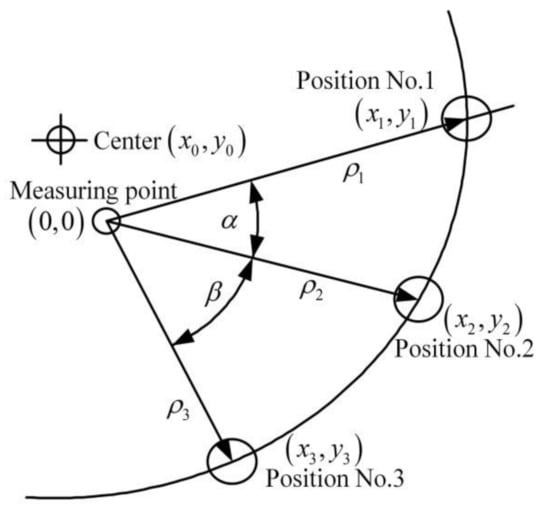
Figure 2.
The principle of measuring the curvature radius.
The measuring point is taken as the coordinate origin, and the direction from the measuring point to position point 1 as the x direction to establish the coordinate system. The coordinates of position No.1, position No.2, and position No.3 are, , and . The center coordinate is . The coordinates of three positions are brought into the equation of circle:
From Equation (1), the center and curvature radius r can be obtained.
3.2. Online Identification of Springback Law
The quantitative description of the relationship between the upper roller reduction and curvature is the basis of realizing the intelligent control of roll bending. The accuracy of quantitative description determines the identification accuracy and prediction accuracy of the intelligent control system. Based on the monitoring results of curvature, the nonlinear fitting method is adopted to process the results of experiments and numerical simulations, so as to identify the relationship between the reduction and curvature.
3.2.1. Experimental Identification
The SFRB device is shown in Figure 3. The main process parameters of the device are shown in Table 1. ST12 cold-rolled plate and 304 stainless steel, both with 2 mm thickness, were chosen. The relationship between the reduction and curvature was studied using 158, 162, 166, and 168 mm lower roller spacing under different reduction conditions.
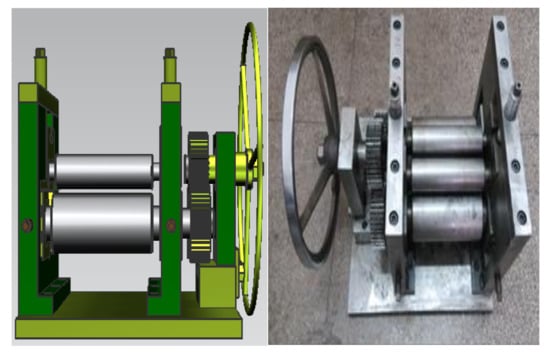
Figure 3.
The SFRB device.

Table 1.
Main process parameters.
When the plate and process conditions are determined, the curvature and reduction are described by Equation (2). The parameters were estimated by the user-defined function equation fitting of Origin Software; the results are shown in Figure 4, and the fitting parameters are shown in Table 2.
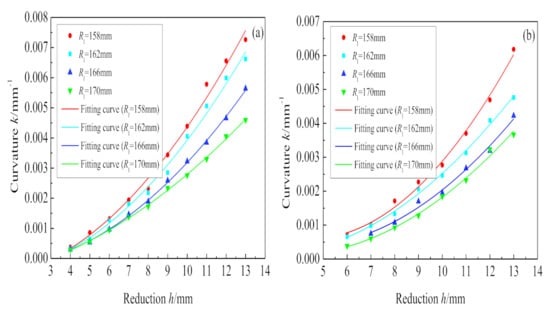
Figure 4.
The relationship between the reduction and curvature from experiments: (a) ST12 cold rolled plate, (b) 304 stainless steel.

Table 2.
Fitting parameters from experiments.
It can be seen from the fitting results that under the condition of keeping the plate and the lower roller spacing unchanged, the relationship between curvature and reduction is a univariate quadratic function. In practical application, this relationship can be used to select the appropriate lower roller spacing and determine the appropriate upper roller reduction.
3.2.2. Numerical Simulation Identification
To increase the accuracy of the research results, the numerical simulation method was used to further verify the relationship between the curvature and reduction. The process parameters of numerical simulations were the same as those of the experiments. The mechanical properties of ST12 cold-rolled plate and 304 stainless steel are shown in Figure 5 and Table 3.
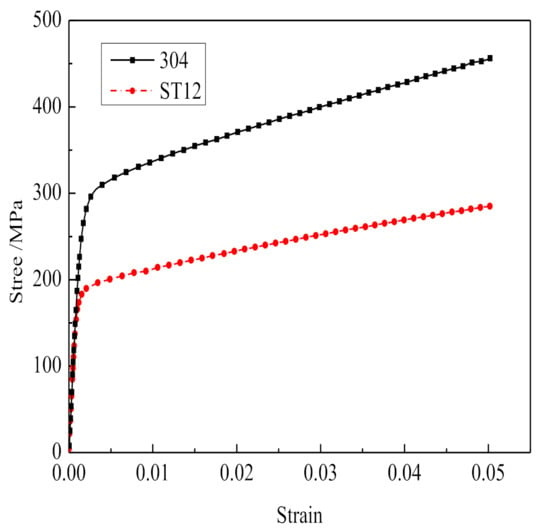
Figure 5.
True stress–strain curve.

Table 3.
Mechanical properties of pipes.
The finite element model of the SFRB process was developed using ABAQUS software, as shown in Figure 6. The two upper rollers and two lower rollers are assumed to be an analytical rigid body. The plate is a deformable body. The master–slave contact condition is set. The frictional coefficient is 0.18. The process was analyzed using the Dynamic/Implicit module.
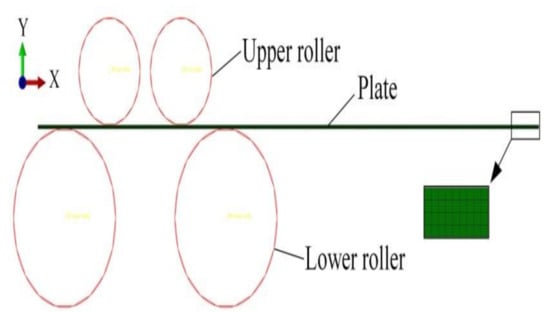
Figure 6.
Numerical simulation model.
The relationship between the curvature and reduction and the fitting parameters from the numerical simulation are shown in Figure 7 and Table 4. It can be seen that the relationship between the curvature and reduction still satisfies the one-dimensional quadratic function for ST12 cold rolled plate and 304 stainless steel.
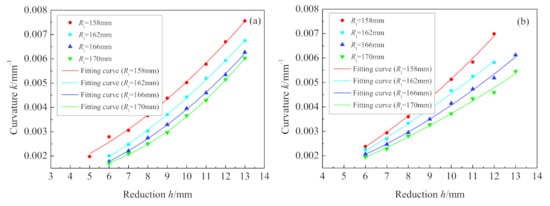
Figure 7.
The relationship between the reduction and the curvature from numerical simulations: (a) ST12 cold rolled plate, (b) 304 stainless steel.

Table 4.
Fitting parameters from numerical simulations.
3.2.3. The Least Square Method
According to the experiments and numerical simulations, the relationship between the curvature and reduction was determined as a univariate quadratic function. To determine the three coefficients in Equation (2), at least three pre-bendings are needed; then, the coefficients of a, b, and c are determined by the least square method. Assuming that the ith reduction corresponding to the curvature ki, and the total number of reductions is n, then the deviation between the curvature and the function curve can be expressed as:
The sum of squared residuals is:
In order to solve the minimum value of S, let:
Then:
The three coefficients can be solved using Equation (6).
3.3. Online Prediction of Final Reduction
Considering the actual detection and specific operation, the determination principle of the initial three reductions is as follows: The first reduction is greater than the elastic limit reduction to ensure plastic deformation. The third reduction is the reduction when the bending curvature before springback is the target curvature , to ensure that the bending curvature after the three pre-bendings does not exceed the target curvature. The second reduction is between the first and the third. According to the above principles, the reduction of the first, second, and third pre-bending are, respectively:
In the rolling process, the maximum strain on the plate section occurs on the outer surface, which can be expressed as:
where, is the strain of outer surface, t is the thickness, and is the radius of curvature of the neutral layer after deformation.
Let
where is the elastic limit strain.
Take Equation (10) into Equation (11), and
where is the radius of curvature of the neutral layer under the elastic limit condition.
Under the condition of four-point bending, the shape of the plate between the two upper rollers is equal to the curvature arc. Due to the short remaining straight edge in the SFRB process, it is assumed that the shape of the slab between the two lower rollers is also an equal curvature arc under the elastic limit condition. The corresponding center angle is , as shown in Figure 8; then:
where L is the plate length between the two lower rollers.
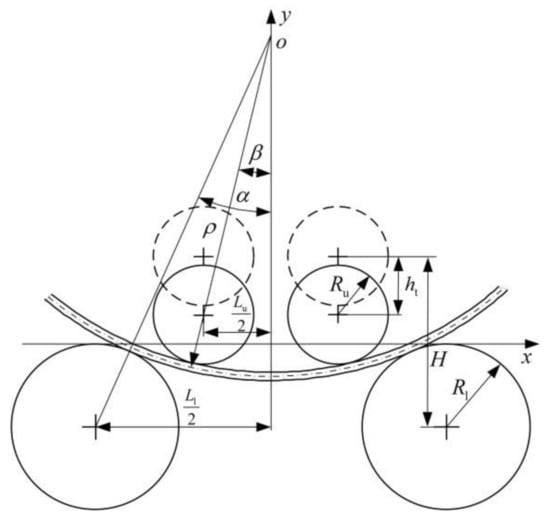
Figure 8.
Geometric relationships in the roller bending process.
According to the geometric relationship, there is:
Substituting Equation (13) into Equation (14), the elastic limit reduction is given by:
When the bending curvature is the target curvature, according to the geometric relationship, can be expressed as:
where H is the initial vertical distance between upper and lower rollers, is the target curvature radius.
Through the on-line monitoring of curvature and the online identification of the springback law, the relationship between the reduction and curvature after rolling n times can be obtained, and the final reduction of forming the target curvature can be calculated as:
In production practice, under the condition of a suitable lower roller span, the relationship between the upper roller reduction and curvature can be determined by pre-bending three times. This can be used to predict the upper roller reduction to roll the shape with an arbitrary curvature, which provides a basis for the control strategy of the four-roller bending process.
3.4. Control Strategy Process
According to the three steps of on-line monitoring of curvature, on-line identification of springback law, and on-line prediction of final reduction, the flow chart of the control strategy for the four-roller process was designed as shown in Figure 9.
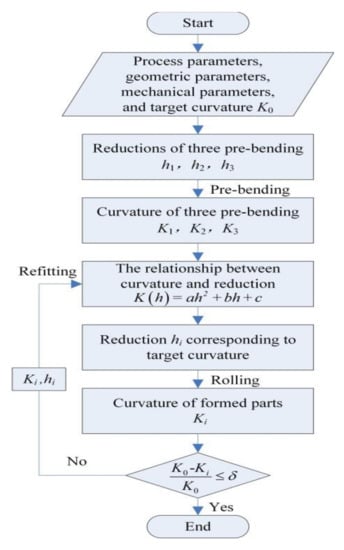
Figure 9.
Flowchart of control strategy.
There are inevitable errors in the measurement after each pre-bending, and the amount of data obtained from pre-bending three times is not enough to accurately fit the curve of the one variable quadratic function of the reduction and the curvature. Therefore, when the curvature of the nth () rolled part fails to meet the accuracy requirements of the target curvature, the results of this rolling can be fed back to the calculation process, the database of relationship of the reduction and curvature can be expanded, and the three coefficients of the quadratic function can be fitted again using the least square method. This further improves the fitting accuracy of the quadratic function until the rolled part meets the accuracy requirements.
4. Experimental Verification
According to the above-mentioned control strategy and the SFRB device, the ST12 cold rolled plate and 304 stainless steel plate were selected for the verification experiments. The thickness was 2 mm. The three pre-bending processes and the forming part are shown in Figure 10 and Figure 11, respectively. The experimental results are shown in Table 5 and Table 6.

Figure 10.
Three pre-bending processes: (a) Pre-bending process, (b) Plate after pre-bending, (c) Plate after second pre-bending, (d) Plate after third pre bending.
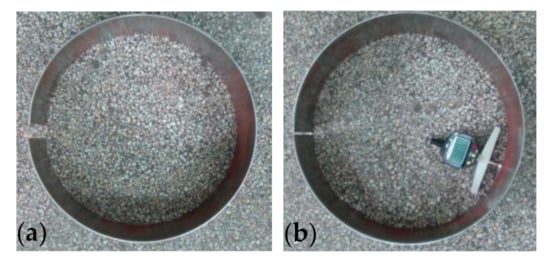
Figure 11.
Forming part: (a) Before modified rolling, (b) After modified rolling.

Table 5.
Experimental results for ST12 cold rolled plate (L 1 =163.5 mm).

Table 6.
Experimental results for 304 stainless steel (L 1 =163.5 mm).
It can be seen from Table 5 and Table 6 that the curvature radius of the formed part, which is formed by the reduction predicted from three pre-bending processes, has a large error with the target curvature. However, using the above control strategy, the rolling data is substituted into the quadratic function fitting process to obtain the revised reduction. After the modified rolling, the accuracy of the formed parts is clearly improved. The rolling error of the ST12 cold rolled plate is 0.3%, and that of 304 stainless steel plate is 0.7%. Through many experiments, the relative error of the curvature radius of the formed parts is within 0.8%, which verifies the feasibility of the control strategy.
5. Conclusions
In this paper, a new symmetrical four-roller bending process is introduced, which consists of feeding, pre-bending, reverse roll bending, second bending, and forward roll bending and unloading. A control strategy of the SFRB process is also presented based on experiments and numerical simulation. The main conclusions are as follows:
- For this process, a control strategy is proposed, including on-line monitoring of curvature, on-line identification of the springback law, on-line prediction of final reduction, and control strategy process.
- A convenient and reliable on-line curvature monitoring method is proposed. The SFRB device was developed and the finite element model was established. Through physical experiments and numerical simulation, the quantitative relationship between the reduction and the curvature was established, which is a quadratic function relationship, as follows:
The online identification of the springback law was realized. An on-line prediction method of the final reduction is proposed, and the determination principle of the reduction of three pre-bending processes is given.
- 3.
- Through physical experiments, the control strategy of SFRB process was verified. The relative error of curvature radius of the final formed parts can be controlled within 0.8%. This research provides new method for intelligent rolling of steel plate.
Author Contributions
Conceptualization, H.C. and G.Y.; Methodology, H.C. and G.Y.; Software, H.C.; Validation, H.C. and C.Y.; Formal analysis, C.Y.; Writing—original draft preparation, H.C.; Writing—review and editing, G.Y. and J.Z.; Supervision, G.Y.; Funding acquisition, G.Y. All authors have read and agreed to the published version of the manuscript.
Funding
This project was funded and supported by the National Natural Science Foundation of China (52005431), and National Natural Science Foundation of Hebei province (E2020203086).
Institutional Review Board Statement
Not applicable.
Informed Consent Statement
Not applicable.
Data Availability Statement
Not applicable.
Conflicts of Interest
The authors declare no conflict of interest.
References
- Zhao, J.; Cao, H.Q.; Ma, L.X.; Wang, F.Q.; Li, S.B. Study on intelligent control technology for the deep drawing of an axi-symmetric shell part. J. Mater. Process Technol. 2004, 151, 98–104. [Google Scholar] [CrossRef]
- Gandhi, A.H.; Gajjar, H.V.; Raval, H.K. Mathematical modelling and finite element simulation of pre-bending stage of three-roller plate bending process. Proc. ASME Int. Manuf. Sci. Eng. Conf. 2008, 1, 617–625. [Google Scholar] [CrossRef]
- Zhang, Z.Q.; Song, J.L.; Fu, J.H.; Li, Y.T.; Guo, Y.N. A refined model of three-roller elastoplastic asymmetrical pre-bending of plate. J. Iron Steel Res. Int. 2014, 21, 328–334. [Google Scholar] [CrossRef]
- Hu, W.; Wang, Z.R. Theoretical analysis and experimental study to support the development of a more valuable roll-bending process. Int. J. Mach. Tool. Manu. 2001, 41, 731–747. [Google Scholar] [CrossRef]
- Gandhi, A.H.; Raval, H.K. Analytical and empirical modeling of top roller position for three-roller cylindrical bending of plates and its experimental verification. J. Mater. Process Technol. 2008, 197, 268–278. [Google Scholar] [CrossRef]
- Fu, Z.; Tian, X.; Chen, W.; Hu, B.; Yao, X. Analytical modeling and numerical simulation for three-roll bending forming of sheet metal. Int. J. Adv. Manuf. Technol. 2013, 69, 1639–1647. [Google Scholar] [CrossRef]
- Quan, T.H.; Champliaud, H.; Feng, Z.K.; Salem, J.; My, D.T. Heat-assisted roll-bending process dynamic simulation. Int. J. Model. Simul. 2013, 33, 54–62. [Google Scholar] [CrossRef]
- Chudasama, M.K.; Raval, H.K. Bending force prediction for dynamic roll-bending during 3-roller conical bending process. J. Manuf. Process. 2014, 16, 284–295. [Google Scholar] [CrossRef]
- Yu, G.C.; Zhao, J.; Zhao, F.P. Elastic-plastic secondary indeterminate problem for thin-walled pipe through the inner-wall loading by three-point bending. Mech. Based. Des. Struc. 2017, 45, 219–238. [Google Scholar] [CrossRef]
- Yu, G.C.; Zhao, J.; Zhai, R.X.; Ma, R.; Wang, C.G. Theoretical analysis and experimental investigations on the symmetrical three-roller setting round process. Int. J. Adv. Manuf. Technol. 2018, 94, 45–56. [Google Scholar] [CrossRef]
- Zeng, J.; Liu, Z.; Champliaud, H. FEM dynamic simulation and analysis of the roll-bending process for forming a conical tube. J. Mater. Process Technol. 2008, 198, 330–343. [Google Scholar] [CrossRef]
- Ktari, A.; Antar, Z.; Haddar, N. Modeling and computation of the three-roller bending process of steel sheets. J. Mech. Sci. Technol. 2012, 26, 123–128. [Google Scholar] [CrossRef]
- Feng, Z.K.; Champliaud, H.; Dao, T.M. Numerical study of non-kinematical conical bending with cylindrical rolls. Simul. Model. Pract. Theory 2009, 17, 1710–1722. [Google Scholar] [CrossRef]
- Salem, J.; Champliaud, H.; Feng, Z.K.; Dao, T.M. Experimental analysis of an asymmetrical three-roll bending process. Int. J. Adv. Manuf. Technol. 2016, 83, 1823–1833. [Google Scholar] [CrossRef]
- Huang, X.Y.; Yu, G.C.; Zhao, J.; Mu, Z.K.; Zhang, Z.Y.; Ma, R. Numerical simulation and experimental investigations on a three-roller setting round process for thin-walled pipes. Int. J. Adv. Manuf. Technol. 2020, 107, 355–369. [Google Scholar] [CrossRef]
- Hua, M.; Baines, K.; Cole, I.M. Bending mechanisms, experimental techniques and preliminary tests for the continuous four-roll plate bending process. J. Mater. Process Technol. 1995, 48, 159–172. [Google Scholar] [CrossRef]
- Hua, M.; Lin, Y.H. Large deflection analysis of elastoplastic plate in steady continuous four-roll bending process. Int. J. Mech. Sci. 1999, 41, 1461–1483. [Google Scholar] [CrossRef]
- Gao, G.Y.; Yu, G.C.; Zhao, J.; Zhang, Z.Y. Rolling round process of four-roll and its springback analysis. J. Plast. Eng. 2017, 24, 55–62. [Google Scholar]
- Wu, K.; Sun, Y.; Cao, C.; Zhou, C.; Liu, Q.; Chang, X. On simulation analysis of plate forming and deformation compensation technology of the side roll for four-roll plate bending machine. Procedia Eng. 2017, 207, 1617–1622. [Google Scholar] [CrossRef]
- Zhou, C.; Sun, Y.; Wu, K.; Liu, Q.Y.; Chang, X.; Sheng, Y.L. Modeling and analysis of process parameters in multi-pass four-roll bending. J. Plast. Eng. 2018, 25, 35–41. [Google Scholar]
- Gu, X.; Franzke, M.; Bambach, M.; Hirt, G. Experimental and numerical investigation of grid sheet bending behavior in four-roll bending. CIRP Ann. Manuf. Technol. 2010, 59, 303–306. [Google Scholar] [CrossRef]
- Yu, G.C.; Zhao, J.; Xu, C.F. Development of a symmetrical four-roller bending process. Int. J. Adv. Manuf. Technol. 2019, 104, 4049–4061. [Google Scholar] [CrossRef]
- Li, J.; Li, X.F.; Chen, G.Y.; Zuo, D.W.; Sun, Y.B.; Li, M.; Zhu, C.F. Experiment and simulation of two-axle bending of 301 stainless steel strip with different hardness values. J. Plast. Eng. 2017, 24, 28–32. [Google Scholar]
- Gong, J.P.; Li, X.F.; Zuo, D.W.; Kang, X.J.; Qiu, J.B. Three-dimensional FEA of manufacturing process of small-diameter split sleeve by two-axle bending. China Mech. Eng. 2015, 26, 1117–1124. [Google Scholar]
- Zhao, J.; Yu, G.C.; Ma, R. A mechanical model of symmetrical three-roller setting round process: The static bending stage. J. Mater. Process Technol. 2016, 231, 501–512. [Google Scholar] [CrossRef]
- Yu, G.C.; Zhai, R.X.; Zhao, J.; Ma, R. Theoretical analysis and numerical simulation on the process mechanism of two-roller straightening. Int. J. Adv. Manuf. Technol. 2018, 9, 4011–4021. [Google Scholar] [CrossRef]
- Li, J. Research on Intelligent Control Technology for Forming the Large Diameter Longitudinal-Seam Submerged ARC Welded Pipes with JCO Process; Yanshan University: Qinhuangdao, China, 2009. [Google Scholar]
- Zhao, J.; Song, X.K. Control strategy of multi-point bending one-off straightening process for LSAW pipes. Int. J. Adv. Manuf. Technol. 2014, 72, 1615–1624. [Google Scholar] [CrossRef]
- Zhao, J.; Zhan, P.P.; Ma, R.; Zhai, R.X. Control strategy of over-bending setting round for pipe-end of large pipes by mould press type method. Trans. Nonferr. Metal. Soc. 2012, 22, 329–334. [Google Scholar] [CrossRef]
- Zhao, J.; Zhan, P.P.; Ma, R.; Zhai, R.X. Prediction and control of springback in setting round process for pipe-end of large pipe. Int. J. Pres. Ves. Pip. 2014, 116, 56–64. [Google Scholar] [CrossRef]
Publisher’s Note: MDPI stays neutral with regard to jurisdictional claims in published maps and institutional affiliations. |
© 2021 by the authors. Licensee MDPI, Basel, Switzerland. This article is an open access article distributed under the terms and conditions of the Creative Commons Attribution (CC BY) license (https://creativecommons.org/licenses/by/4.0/).